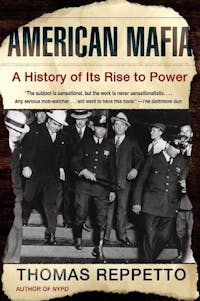American Mafia
A History of Its Rise to Power
 Download image
Download image
ISBN10: 0805077987
ISBN13: 9780805077988
Trade Paperback
352 Pages
$23.00
CA$31.50
American Mafia provides a balanced, well-researched history of the Mafia's origin and devleopment in the New World, from the 1880s to the post-WWII era.
Structuring his narrative around a series of case histories featuring such infamous characters as Lucky Luciano and Al Capone, Reppetto, a former police detective, draws on a lifetime of field experience and access to unseen documents to reveal a locally grown Mafia. The nation's first crime families, we find, were initially shaped by living and working conditions in a variety of ethnic neighborhoods in big cities across the country, but it wasn't until the 1920s, thanks to Prohibition, that the Mafia assumed what are now seen as its defining characteristics, especially its Italian American ties and its octopus-like tendency to infiltrate industry and government. At mid-20th-century, the Kefauver Commission declared the Mafia synonymous with Union Siciliana; in the 1960s, the FBI finally admitted the Mafia's existence under the name La Cosa Nostra.
As accessible as it is authoritative, American Mafia is a fascinating study of America's most compelling criminal subculture—from an author well-acquainted with both sides of the street.
Reviews
Praise for American Mafia
"[This] clear-eyed study portrays a Mafia that managed to be both national in scope and—despite investigators' hunt for an elusive 'Mr. Big'—surprisingly decentralized. Reppetto covers the usual suspects, like Luciano and Capone, but is particularly fascinated by the intersection of Mob life with the establishment."—The New Yorker
"American Mafia: A History of Its Rise to Power is a smart, reasoned study of the ascendancy of Italian-American organized crime that begins with a few bad guys sprinkled among the waves of honorable Italian immigrants in the late 19th century and ends with the Kefauver Committee hearings in the early 1950's, which exposed the mob's broad influence in major American cities. Though the bookshelves cry for mercy under the weight of Mafia literature, Reppetto's book earns its place among the best, in part because he rarely lapses into belly-full-of-lead prose. And by narrowing his focus, he brings fresh context to a familiar story worth retelling: how Italian-American gangs across the country formed a crime organization that, for all the corporate spin about code and honor, was designed to maximize profit and minimize any mayhem that might disrupt the flow of said profit . . . Reppetto strives to clear away the romantic muck that often shrouds the history of the mob . . . Separating fact from fiction did not leave Reppetto wanting for material, however. He vividly describes the assassination of the New Orleans police chief in 1890 and the subsequent lynching and murder of alleged Mafiosi, which were punctuated by the mocking chants of vengeful rioters. And his account of how a few overworked and neglected prostitutes brought down the mighty Luciano is delicious . . . [The author] has navigated a world of wacky nicknames and Machiavellian alliances—of false romance and coldblooded greed—to provide a lucid history of the American Mafia."—Dan Berry, The New York Times Book Review
"The subject is sensational, but the work is never sensationalistic . . . Any serious mobwatcher [must] have this book."—The Baltimore Sun
"Estimable . . . Mr. Reppetto's history is richly detailed . . . American Mafia isn't all names, prosecutions, and rub-outs. [The book] addresses larger concerns, like the connection between the Sicilian mafia and the American one, arguing that they are in fact separate entities. The arrival in the U.S. of certain Italian undesirables in the early 1900s did not, he notes, result in the creation of organized crime, as is commonly believed. Rather, the bad guys found a home for themselves in a criminal network that already existed under Jewish and Irish gangsters and in institutions like Tammany Hall. With equal scrutiny, Mr. Reppetto looks at the Mafia's opponents, including Thomas Dewey, New York's ambitious district attorney of the late 1930s, and J. Edgar Hoover, who often seemed indifferent to the Mafia, although the FBI crime lab, together with various FBI programs, improved the work of local police departments. But most notably Mr. Reppetto writes of the exploits of the Italian crime-busters. Indeed, the role Italian-Americans played in fighting the Mafia is as strong as the role they played in it."—Victorino Matus, The Wall Street Journal
"Reppetto's history of the American Mafia, from its humble turn-of-the-century beginnings in small Italian neighborhoods to the 1950-51 Senate's Kefauver hearings on organized crime that made the mob front-page news, seeks to set the record straight about one of America's most mysterious organizations. Though Reppetto, a former cop, acknowledges that the American Mafia was an outgrowth of the Sicilian and Neapolitan criminal guilds, he finds only a loose connection between the American Mafia and its old country counterparts. Citing the bad business practices of killers like Al Capone, Reppetto makes it clear that it was the mob's political ties, especially to the Tammany groups in Manhattan and the mayor's office in Chicago, and not murder and mayhem, that made rich men of many Italians (as well as Poles, Irishmen, and Jews) who came to America with nothing. Without condoning their tactics, Reppetto makes a strong case that the men who laid the foundation for a national 'syndicate' were empire builders along the lines of the Astors and Vanderbilts, and that the Mafia's decline since the 1950s is as much a reflection of the lack of new, strong mob leadership as it is a result of less political protection and a federal crackdown that stemmed from the mob's newfound notoriety . . . [Reppetto] presents a thought-provoking depiction of the mob devoid of the sensationalism prevalent in many other portrayals."—Publishers Weekly


